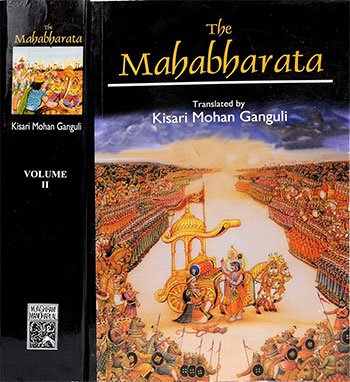Section CLII - Pandavas March to Kurukshetra: Warriors in Battle-array
Book index: Mahabharata (English)
This page contains a summary of the Mahabharata Section CLII including examples of moral lessons in daily life. The Maha-Bharata is one of the largest epics ever written containing roughly 100,000 Sanskrit verses. It deals with the legendary history of ancient India and contains a large number of interwoven tales.
Short summary of the chapter:
The Pandavas, accompanied by a vast army, set out for the battlefield of Kurukshetra, leaving Draupadi and their belongings at Upaplavya. Led by Bhima, Arjuna, and the other warriors, they marched with great joy and enthusiasm, with the sound of their movements resembling a raging river. King Yudhishthira ensured the safety and well-being of the non-combatants and necessary supplies as they journeyed towards the battlefield. The marching army was a formidable sight, with the princes of various kingdoms following behind the Pandavas, ready for battle.
The Pandavas' army included powerful warriors like Dhrishtadyumna, Sikhandin, and the princes of Kekaya, among others, all decked out in armor and armed for combat. Arriving at Kurukshetra, the sons of Pandu signaled their presence with the loud blasts of their conchs, filling the air with a sense of anticipation and excitement. The soldiers, horses, and elephants in their army created a thunderous uproar as they prepared for the impending battle, exuding confidence in their strength and determination. Krishna and Arjuna's conchs added to the majestic sound, inspiring their troops and instilling fear in the hearts of their enemies.
The march of the Pandavas towards Kurukshetra symbolized their unwavering determination and readiness to fight for what was rightfully theirs. With their mighty army in formation, the Pandavas showcased their military prowess, drawing the attention and admiration of all who witnessed their grand procession. The roar of the warriors, the blare of the conchs, and the beat of drums created an atmosphere charged with energy and anticipation as the battlefield awaited the clash of these powerful forces. The Pandavas, led by their valiant leaders, set the stage for an epic battle that would determine the course of the war and the destiny of the kingdoms involved.
Full English translation:
This page is merely a summary which is automatically generated. If you are looking for authentic sources such as the Sanskrit text or the Full English translation of Mahabharata Section CLII - Pandavas March to Kurukshetra: Warriors in Battle-array, have a look at the following articles:
Section CLII, online text
English translation by Kisari Mohan Ganguli.
Read this and other chapters online.
Mahabharata (English Summary)
by Kisari Mohan Ganguli | ISBN-10: 8121505933
Buy the latest edition:
FAQ of Mahabharata, Section CLII:
What was the reaction of the monarchs when Krishna spoke?
The monarchs were filled with joy and shouted with excitement. The troops quickly prepared for battle, creating a thunderous din with their movements and war-cries.
Who led the Pandava army in the march to Kurukshetra?
Bhimasena, the sons of Madri, Subhadra's son, and others led the Pandava army. Yudhishthira accompanied them along with their supplies, while Draupadi stayed back with the camp-followers.
Daily life: Pandavas March to Kurukshetra: Warriors in Battle-array:
The passage narrates an epic scene of preparation and unity, showcasing how the Pandavas, filled with joy and determination, rallied together for a cause. From this, we learn the importance of collective effort and readiness for any challenge. It highlights how meticulous planning, including provisioning for essential needs and ensuring everyone is well-prepared, is crucial before embarking on any significant endeavor. Moreover, the story emphasizes maintaining high spirits and morale, as seen in the joy and war cries of the Pandavas' troops, which is essential for overcoming difficulties.
In daily life, this can translate to setting clear goals and collaborating effectively with others towards achieving them. It reminds us to prepare thoroughly, considering all necessary resources and potential obstacles. Additionally, it underlines the value of encouragement and support within a team to keep morale high. Whether it's a work project, a community effort, or personal goals, approaching tasks with enthusiasm, unity, and thorough planning can lead to success.
